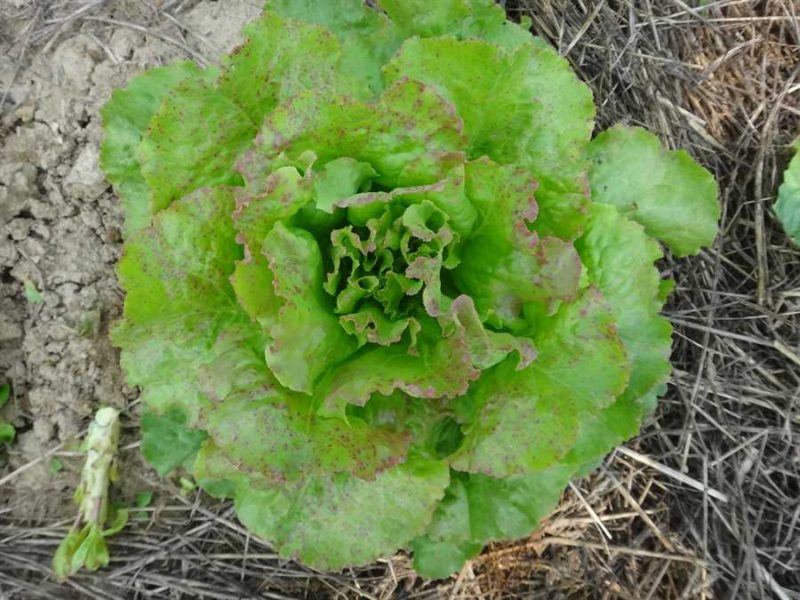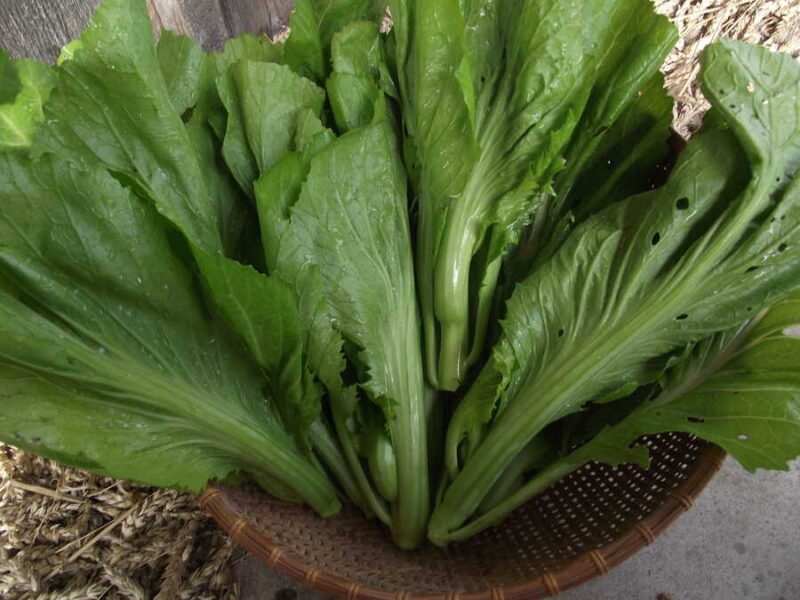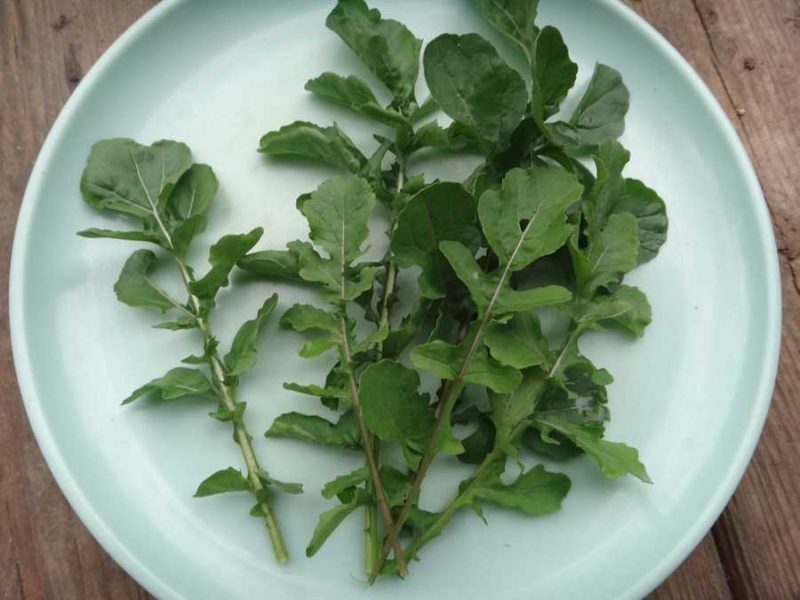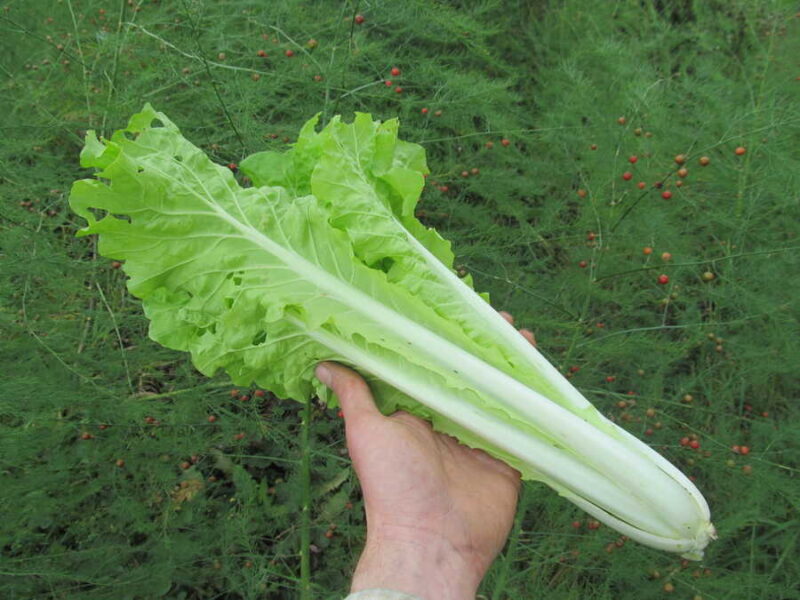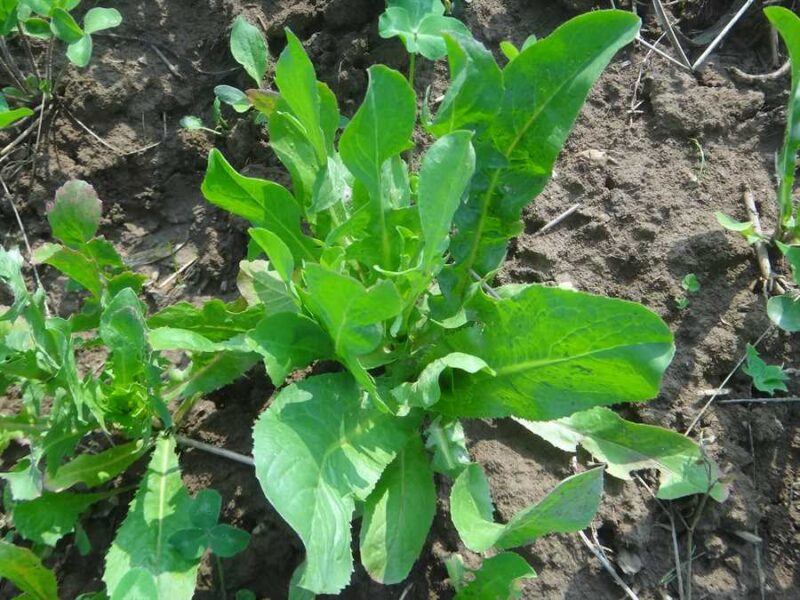Skip to content

-
-
-
$4.00 – $6.00Price range: $4.00 through $6.00
- (Lactuca sativa) A cold-hardy, slow-bolting lettuce; forms loose heads/ lots of close-set leaves which are light green with faintly bronzed margins as they mature.
- Select options
This product has multiple variants. The options may be chosen on the product page
-
-
Out of Stock
-
$4.00
- (Hablitzia tamnoides) A most interesting perennial green, because it combines a pleasant flavour and shade tolerance. Hablitzia (we always refer to it by its Latin genus name) is a vine, which sends out many shoots in the spring. You can eat some of the shoots or allow them to grow and pick individual leaves for eating. The taste is like mild spinach, and it can be eaten raw or cooked.…
- Read more
-
-
-
$4.00 – $6.00Price range: $4.00 through $6.00
- (Cichorium endiva) Crisp, juicy heads have a pleasant touch of bitterness. Escarole is ideal for autumnal salads; as frost begins and lettuce quits, it takes over to extend the salad season. Cornet de la Loire develops large, upright heads when summer sown for fall eating, and loose leaves with no head when spring planted.
- Select options
This product has multiple variants. The options may be chosen on the product page
-
-
-
$4.00 – $10.00Price range: $4.00 through $10.00
- (Brassica juncea) – 大坪铺包心大芥菜 A delightful Chinese head mustard for fall use (it will bolt if it experiences too much heat, so don’t attempt it in spring). Small heads have charmingly curved leaves with enormous petioles (the leaf midrib/stem); the leaf itself has a sulphurous, fiery burn (delightful!) while the petiole is milder with a hint of sweetness. A satisfyingly hefty vegetable. Brilliant for lacto-fermentation with salt, garlic and cayenne,…
- Select options
This product has multiple variants. The options may be chosen on the product page
-
-
-
$4.00 – $10.00Price range: $4.00 through $10.00
- (Brassica juncea) One of those plants so beautiful that harvesting efficiently is only possible if you don’t look too closely. I actually pulled one up and put it in a vase as a bouquet for our table in mid-November! If you do look closely, you’ll find yourself mesmerized by the delicate tracery of purple lines spreading across the green leaves with their brilliant white veins. It looks like a map…
- Select options
This product has multiple variants. The options may be chosen on the product page
-
-
-
$4.00 – $10.00Price range: $4.00 through $10.00
- (Brassica juncea) A very cold-hardy leaf mustard. Hot raw, milder if lightly cooked. The name, interestingly, is a "sense-for-sense" translation of its Chinese name (雪里红) which literally means “red in snow.” In Chinese culture, red symbolizes health, joy, and luck which, I would deduce, matches this mustard's approach to winter.
- Select options
This product has multiple variants. The options may be chosen on the product page
-
-
-
$4.00 – $10.00Price range: $4.00 through $10.00
- (Eruca sativa) As the name suggests, this is a cold-hardy variety with deeply lobed, powerfully flavoured leaves.
- Select options
This product has multiple variants. The options may be chosen on the product page
-
-
-
$4.00 – $6.00Price range: $4.00 through $6.00
- [Beta vulgaris] – Also called spinach beet, this chard dates back to the 1700s. It has been our family’s main spinach substitute for years. It has nearly all of spinach’s advantages, with none of its downsides: nutritious, good in salads or as a cooked green, but with a slightly milder flavour and larger leaves. The crucial advantage is that the plants don’t bolt in their first summer, because, like beets,…
- Select options
This product has multiple variants. The options may be chosen on the product page
-
-
Out of Stock
-
$4.00
- (Valerianella locusta) An extremely cold-hardy salad green which stays green right through the winter in our garden, corn salad’s main downside is that it has tiny leaves – not easy to harvest enough for a salad, especially if you’re rooting around in the snow for it! Piedmont has larger leaves than most – up to 4”. Corn salad readily self-seeds, so if you let it mature once you’ll have it…
- Read more
-
-
-
$4.00 – $10.00Price range: $4.00 through $10.00
- (Brassica napus) Very similar to Red Russian, but with slightly larger plants. This kale is very cold hardy. We overwintered it in the garden, and cold did not appear to trouble it – though the deer did; if you have deer where you live, take precautions! I was intrigued by this kale because in the spring of its second year it bolts later than most kales, providing a source of…
- Select options
This product has multiple variants. The options may be chosen on the product page
-
-
-
$4.00 – $10.00Price range: $4.00 through $10.00
- (Brassica oleracea) The Shetland Islands, north of Scotland, have a harsh climate with very long winters. Few vegetables can be grown there, but one which is hardy enough to survive and thrive is this kale! An old landrace whose flat green leaves are tinged with purple, Shetland kale has been grown on the islands for at least 400 years, possibly longer. So it is probably one of your best chances…
- Select options
This product has multiple variants. The options may be chosen on the product page
-
-
-
$4.00 – $10.00Price range: $4.00 through $10.00
- (Brassica oleracea) A giant kohlrabi ideal for winter storage: still tender and delightful when 8-10” across and keeps for months in a root cellar (we have eaten our last overwintered kohlrabis in August!). We think it’s brilliant, especially grated for a nice fresh coleslaw in February. Also try pairing it with lots of parsley in late-fall salads. Kohlrabi is fascinatingly bizarre-looking in the garden, and deserves just as much attention…
- Select options
This product has multiple variants. The options may be chosen on the product page
-
-
$4.00 – $10.00Price range: $4.00 through $10.00
- (Brassica oleracea OR B. napus) Also called Càil Cataibh in Gaelic. A flatleafed green kale from northern Scotland. “Sutherland” is a historical county named in the era of Norse rule when the Earl of Orkney considered it “southern land” (Suðrland) – compared to the rest of his holdings in Orkney and Caithness! From the perspective of the rest of us, it’s about as far north as you can go. Multiple…
- Select options
This product has multiple variants. The options may be chosen on the product page
-
-
-
$4.00 – $10.00Price range: $4.00 through $10.00
- (Brassica rapa) Tat soi is a wonderful plant from East Asia. It is our family’s favourite cooking green for growing in the late fall and early spring because it thrives in cold weather and stays very short, ideally suited for overwintering in our cold frames. Instead of growing up, these non-heading relatives of pak choi/bok choy grow out, with spreading circles of small, tender dark green leaves. In a fun…
- Select options
This product has multiple variants. The options may be chosen on the product page
-
-
-
$4.00 – $10.00Price range: $4.00 through $10.00
- (Brassica rapa) Combines the best features of lettuce and pak choi: mild, sweet, succulent, with broad, tender petioles. Fast-growing, cold- and heat-tolerant, this is ideal for salads or stir-fries. A non-heading relative of Chinese cabbage; Tokyo Bekana’s ancestors came to Japan from the mainland in the late 19th or early 20th century, and it was then developed into its present form by gardeners and seed producers in the Tokyo area.…
- Select options
This product has multiple variants. The options may be chosen on the product page
-
-
Out of Stock
-
$4.00 – $8.00Price range: $4.00 through $8.00
- (Spinacea oleracea) A very cold-hardy spinach with large, dark green leaves. Can be grown spring or fall.
- Select options
This product has multiple variants. The options may be chosen on the product page
-
-
Out of Stock
-
$4.00
- (Chenopodium spp. [mostly C. album]) (Not germination tested*) Many people consider this a weed. It is admittedly self-seeding, prolific, and fast growing. But we love to eat it until we turn green and lambsquarters is an annual which is easy to kill by hoeing, so we look at it as a wonderfully easy-to-grow food rather than a weed! We basically always eat it blanched and drained to leach the anti-nutritional…
- Read more
-
-
-
$4.00 – $8.00Price range: $4.00 through $8.00
- (Petroselinum crispum) Tightly curled, finely cut frilly leaves on strong stems. An excellent, productive and delicious parsley with impressive cold-hardiness; we have kept harvesting even when we have to dig down through the snow to find the plants! It makes an excellent winter salad when great quantities are paired with shredded kohlrabi (about 1/3 parsley and 2/3 kohlrabi).
- Select options
This product has multiple variants. The options may be chosen on the product page
-
-
-
$4.00 – $6.00Price range: $4.00 through $6.00
- (Cichorium endiva) Looks like a giant dandelion, but tastes much better! The name is descriptive; it is like a ‘little cardoon” and comes from Bari, Italy. Cold hardy and slow bolting annual; when it does bolt, the side branches can be eaten, sort of like a cross between escarole and celery. An interesting mix of bitter and sweet.
- Select options
This product has multiple variants. The options may be chosen on the product page
-
-
-
$4.00 – $6.00Price range: $4.00 through $6.00
- (Lactuca sativa) An oakleaf lettuce bred by Frank Morton from a cross between ‘Blushed Butter Oak’ and ‘Deer Tongue’. Excellent flavour and texture, and partial heading at maturity. OSSI Pledged.
- Select options
This product has multiple variants. The options may be chosen on the product page
-
-
-
$4.00 – $6.00Price range: $4.00 through $6.00
- (Lactuca sativa) A dramatically colourful lettuce bred by Frank Morton of Wild Garden Seeds, this is the result of a cross between ‘Flashy Troutback’ and ‘Emerald Oak.’ Slow to bolt and, if you can bring yourself to devour such a showy plant, delicious. OSSI pledged.
- Select options
This product has multiple variants. The options may be chosen on the product page
-
-
Out of Stock
-
$4.00 – $6.00Price range: $4.00 through $6.00
- (Lactuca sativa) My mother likes red lettuce. Very red lettuce; the darker, the better, in her opinion. She insisted that we grow this one. A leaf lettuce with crinkled, deep red leaves, Merlot bolts slowly and is a beautiful addition to salads.
- Select options
This product has multiple variants. The options may be chosen on the product page
-
-
-
$4.00 – $10.00Price range: $4.00 through $10.00
- (Eruca sativa) A pleasantly spicy arugula with relatively broad, shallowly-lobed leaves which gives lots of quantity per plant – efficient for pesto making! Excellent for fall growing. Named for the man who brought it to North America, this variety was spread by Seed Savers Exchange. They had received it in the mid-1990s from Hans Hansen of Peaceable Kingdom School in Washington, Texas; he had gotten seed from Enrico “Ric” Rao…
- Select options
This product has multiple variants. The options may be chosen on the product page
-
-
-
$4.00 – $10.00Price range: $4.00 through $10.00
- (Lepidium sativum) A garden cress with a powerful, distinctive bite, best described by comparing it to an alligator in a turbid river (not in a negative way, of course!). Bred by Frank Morton of Wild Garden Seeds from a cross between ‘Persian’ and ‘Curly’ cress, this is apparently his most popular introduction. OSSI pledged.
- Select options
This product has multiple variants. The options may be chosen on the product page
-
-
-
$4.00
- (Rumex acetosa) A perennial with succulent leaves which can be treated as an herb; but we mostly like to add it to salads in more substantial quantities for its acidic, lemony bite. Produces leaves early in the spring, then bolts for seed, and then has a second flush of leaves in the fall, helping to extend the fresh greens season on both ends. Readily self-seeds, so if you don’t want…
- Add to cart
-
-
-
$4.00
- (Sanguisorba minor) Delicate little green gives a fine, cucumber-like flavour to salads in spring – months before you could possibly have cucumbers. Cold-hardy, self-seeding and beautiful, this could also make an interesting ornamental for places where a small plant with subtle beauty of form is preferred to a splash of colour.
- Add to cart




